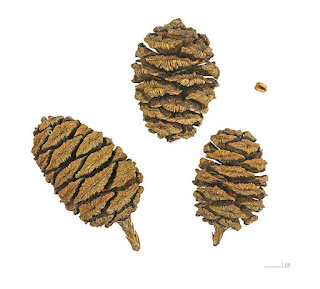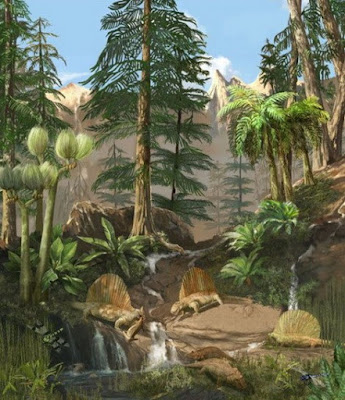From Sequoiadendron gigantium to Welwitschia. The tall and short of gymnosperms.
There are several phyla which became extinct towards the end
of the Mesozoic era 65 million years ago, such as the Pteridospermales and
Cordaitales, however, this blog will focus on the 4 extant phyla, Coniferophyta
(conifers), Cycadophyta (cycads), Ginkgophyta (ginkgo) and Gnetophyta
(gnetophytes) (Evert and Eichhorn 2013).
The most abundant of all gymnosperms, with approximately 630
species, are the conifers, Coniferophyta (Evert and Eichhorn 2013). These
include some of the more commonly known like red woods, pines, firs and cypresses,
and others less familiar such as larches, bristlecones, junipers, yews and plum
yews (Rost 1998).
Not all conifers are cone bearers as the phylum name suggests.
Junipers, yews and plum yews are unique in that they lack woody cones.
 |
| Giant Sequoia pinecones |
They
have seeds which are surrounded by a fleshy, berry like tissue, called an aril,
and are fruit like in appearance (Rost 1998). There are other unique features
within the conifer group. Although most conifers are evergreens, retaining
leaves throughout the four seasons, larches and some members of the redwood
family are deciduous and shed their needle like leaves in autumn (Reece and
Campbell 2012).
 |
| The world's largest tree, General Sherman, Sequoiadendron gigantium, Located in Sequoia National Park |
The world’s largest trees are giant sequoia, Sequoiadendron
gigantium, and can weigh approximately 2500 tonnes. The tallest trees
are coast redwoods, Sequoia sempervirens,
growing to more than 110 metres tall. The oldest known tree is a bristlecone
pine, named Methuselah, approximately 4600 years old (Reece and Campbell 2012).
 |
| Bristlecone Pines, similar to the world's oldest tree Methuselah, it's exact location is kept secret. |
Found in tropical and subtropical regions, cycads, Cycadophyta,
make up the next largest group with approximately 300 species. They have a palm
like appearance as the leaves occur in a cluster at the top, growing directly
from the cylindrical trunk, resembling a palm tree. Cycads can be toxic,
containing both neurotoxins and carcinogens (Evert and Eichhorn 2013). Like
pines, cycads have large cones. However, unlike conifers, cycads are diecious,
having pollen from male cones and eggs from female cones on different individual
plants (Rost 1998).
 |
| Cycadophyta with cone. |
Ginkgo Bilboa, the
maiden hair tree, is the sole surviving member of Ginkgophyta. Grown for
centuries as a decorative tree, and more recently in suburban areas due to its
high pollution tolerance, it is only found naturally in the wild in temperate
forests of China. Like cycads, it is diecious (Rost 1998).
Gnetophyta comprises of Ephedra,
Gnetum and Welwitschia, and are all diecious. Ephedra has 40 species and is grown for the
medicinal compound ephedrine, used in decongestants (Reece and Campbell 2012). Gnetum has around 30 tropical species
native to Asia and Africa and are mainly lianas (climbing vines) (Rost 1998).
Finally, Welwitschia, is found along
the southwest coast of Africa, thrives in desert conditions and can live for one
to two thousand years (Rost 1998).
References
Evert, R.F., Raven, P.H. & Eichhorn, S.E. 2013, Biology of plants, Eighth edn, W.H.
Freeman and Company Publishers, New York.
Reece, J.B. & Campbell, N.A. 2012, Campbell biology, 9th (Australian version) edn, Pearson Australia,
Frenchs Forest, N.S.W.
Rost, T.L. 1998, Plant
biology, Wadsworth, Belmont, Calif.
James R Bouldin 25 January 2006, Bristlecone Pine, image, viewed May 2018, < https://en.wikipedia.org/wiki/Bristlecone_pine#/media/File:Prometheus_Wheeler.jpg->.
Christian Kober Getty
Images 2018, Sequoiadendron gigantium,
image, viewed May 2018, < https://www.thespruce.com/great-trees-of-the-world-1709081>.
Pixabay.com, Images 2018, Cycadophyta, image, viewed May 2018, < https://pixabay.com/en/cycads-flower-sago-palm->.
Wikipedia, Author unknown 2018, Giant Sequoia Pinecone, image, viewed May 2018, < https://en.wikipedia.org/wiki/File:Sequoiadendron_giganteum_MHNT.BOT.2004.0.191.jpg->.



I know that Welwitschia is a monotypic genus. What has allow this species to survive, when other members of this genus (if there were likely any?) went extinct?
ReplyDelete